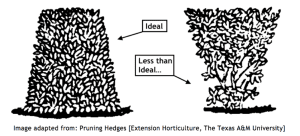I came home the other day and two nice men were working on my neighbour’s hedge. I don’t know for sure that were nice men, I did not talk to them – that would have been weird. I assumed that they were nice because they had set up the work site with cones and barrier tape, they had PPE (Personal Protective Equipment) and used proper tools. They were for all intents and purposes, professional (which I also assumed to be the case, even though they were not in company clothing and the very appropriate vehicle they had was not sign written).
So, the two ‘probably’ nice men, were taming a hedge that had become disobedient, and because they ‘seemed’ professional, I had every faith that they would do a good job. But they did not. Maybe they were not professional, maybe they were not nice, maybe I should have spoken to them – maybe I should go and fix the neighbour’s hedge?
To their credit, the wrong doing that they did is very common, so common that they and my neighbours most likely believe that they did a good job. Their failing was that they didn’t angle the face of the hedge – a hedge needs to be slightly wider at the bottom than at the top.

By cutting a hedge this way, you will allow sunlight to reach the bottom of the hedge. You will encourage even growth and maintain a healthy face form the top right down to ground level. If a hedge is cut vertical, or worse… wider at the top than at the bottom, then the lower section of the hedge will be shaded and the top, receiving more sun, will grow faster and the shading will worsen. Due to the reduced light, growth at the bottom of the hedge will be stunted and eventually sections will start to die off. The top will become ‘top heavy’ and top growth may become uneven – in an attempt to control the top, trimming often becomes irregular and before long the hedge will most likely start to develop waves and contours. Once the waves start your hedge will no longer be a controlled, managed and structured feature. Your hedge will develop a life of its own and eventually your hedge will become an amorphous weed.
If you want an amorphous weed, plant a screen – a screen being a collection of plants planted in close proximity and left to grow. If you want a hedge, then manage your screen by trimming it, ensuring that the bottom of the screen is wider than the top – a controlled, managed and structured screen is a hedge.
- So how does one trim a hedge?
Knowing that sharp well-maintained tools, correct PPE, safety precautions and appropriate ladders (well footed and not overextended when in use) are a given; find the widest part of the hedge, then starting at the bottom cut a face moving up towards the top. You need to keep sufficient growth and/or buds in the face of the hedge to ensure the face will continue to grow, and angle the face so it is wider at the bottom than at the top. - Once you have established a face (at the widest part) cut/blend the rest of the hedge back to meet it – always starting at the bottom and cutting on a slight angle up towards the top
- Once you have established a face along the full length of the hedge, cut the top to the desired height.
The tighter the clipping the more ‘formal’ the hedge will look – and if you are wanting a very formal (highly manicured) hedge, then consider going back a couple of days after you have trimmed it and snip off the bits that have popped out – because there will be some.
A well-shaped hedge is no accident, it must be trained from the beginning, it must be trimmed to the desired shape before the hedge grows to its desired size – and it must be kept trimmed; a little bit often, not a lot once but infrequently.
0 Comments